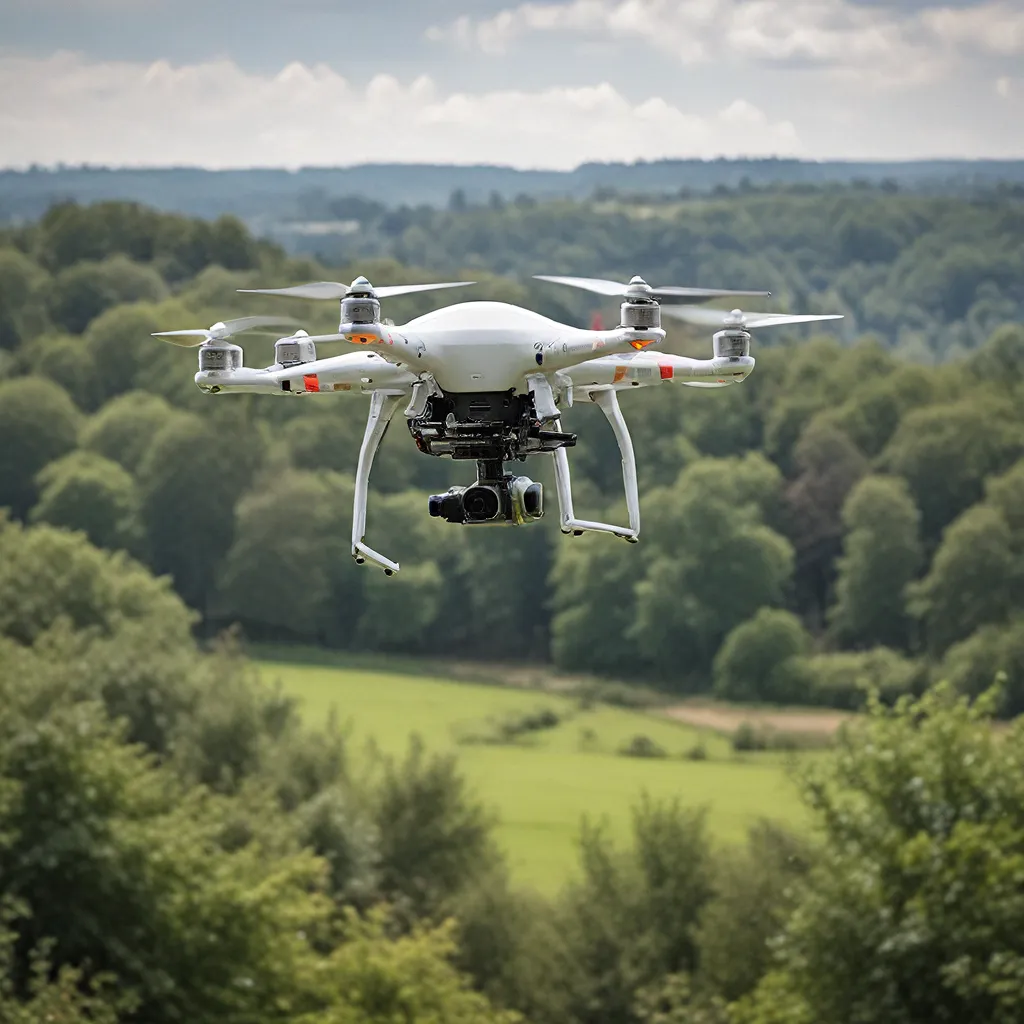
The Evolving Battleground: From Manned to Unmanned
I’ve always been fascinated by the rapid evolution of drone technology and its incredible impact on modern warfare. As the founder of Coulsdon Drones, I’ve had a front-row seat to this revolution, and I can tell you with certainty that the future of military might lies in the skies above.
Just a few decades ago, the idea of unmanned aerial vehicles (UAVs) playing a pivotal role in armed conflicts was the stuff of science fiction. But today, these highly capable and versatile platforms have become an indispensable part of every military’s arsenal. From intelligence, surveillance, and reconnaissance (ISR) missions to targeted strikes and precision-guided munitions, drones have transformed the very nature of modern warfare.
In my view, the key driver behind this revolution is the stunning pace of innovation in dual-use technologies (DUT). These cutting-edge advancements, often pioneered in the commercial sector, have rapidly found their way into military applications, eroding the long-held advantage of traditional, manned weapon systems (MWS).
As I like to say, the world of defense is no longer just about big, expensive platforms. It’s about agility, adaptability, and the ability to leverage the latest technological breakthroughs – whatever their origin. And that’s where Coulsdon Drones comes in. We’ve made it our mission to help our military and government clients stay ahead of the curve, mastering the aerial advantage through innovative drone solutions and unparalleled expertise.
Navigating the Dual-Use Frontier
One of the key insights from the research on defense innovation systems (DIS) is the growing importance of DUT as a source of military-relevant technologies. Gone are the days when the Department of Defense (DOD) could rely solely on its own research and development (R&D) efforts or the output of the Big Six defense contractors.
Today, the innovation landscape is far more dynamic and decentralized, with a myriad of commercial players constantly pushing the boundaries of what’s possible. And this has significant implications for how nations must approach military competition. As the authors note, “challenger nations generally benefit when innovations become easier to adopt” – and that’s precisely the situation we’re seeing with the rise of DUT.
At Coulsdon Drones, we’ve made it our mission to stay ahead of this curve, constantly scouring the global innovation ecosystem for the latest breakthroughs that can give our clients a decisive edge. Whether it’s advanced sensors, autonomous flight systems, or novel propulsion technologies, we’re always on the lookout for the next big thing.
But it’s not just about identifying the latest and greatest tech. It’s also about understanding how to effectively integrate these dual-use innovations into military applications. And that’s where our deep expertise really shines. We’ve honed our skills in network-based innovation, working closely with a diverse array of partners – from startups to defense primes – to rapidly field cutting-edge solutions.
Outpacing the Competition through Organizational Agility
One of the key advantages that Coulsdon Drones brings to the table is our organizational agility. Unlike the lumbering bureaucracies of many government agencies or large defense contractors, we’re able to move at the speed of innovation, quickly adapting to changing market conditions and technological breakthroughs.
As the research indicates, the pace of innovation in DUT systems is often far outstripping that of traditional MWS. And this presents a significant challenge for the DOD, which has historically been geared towards the slower, more deliberate pace of major weapons development.
But at Coulsdon Drones, we’ve embraced a different approach. We’ve built a nimble, flexible organization that can rapidly prototype, test, and field new drone solutions in response to evolving client needs and emerging threats. Our network of partners gives us unparalleled access to the latest innovations, while our internal processes enable us to quickly integrate these breakthroughs into highly capable, mission-ready systems.
Importantly, we’re not just focused on the technical side of the equation. We also deeply understand the organizational and cultural factors that can either facilitate or hinder the adoption of new technologies. That’s why we work closely with our clients to carefully navigate the often complex and bureaucratic waters of defense acquisition, helping them overcome the institutional inertia that can so often impede innovation.
Cultivating a Culture of Creativity and Collaboration
At the heart of Coulsdon Drones’ success is our unwavering commitment to fostering a culture of creativity and collaboration. We firmly believe that innovation doesn’t happen in a vacuum; it requires the cross-pollination of ideas, the free flow of information, and the willingness to take calculated risks.
That’s why we’ve built an organization that actively encourages our team members to think outside the box, to challenge conventional wisdom, and to explore new and unconventional approaches to problem-solving. We’ve created an environment where failure is not only accepted but celebrated – because we know that some of the most groundbreaking innovations often emerge from the ashes of previous missteps.
But it’s not just about our internal team. We also place a premium on partnering with a diverse array of organizations, from academic institutions to small tech startups to our fellow defense industry players. We understand that the most exciting and impactful innovations often arise at the intersection of disparate disciplines and perspectives.
As the research highlights, the DOD has a long history of using networks and collaborative partnerships to drive innovation within the defense sector. And we’ve taken this lesson to heart, actively cultivating a vibrant ecosystem of innovators who can help us stay ahead of the curve.
Whether it’s hosting hackathons, sponsoring research grants, or simply fostering open lines of communication, we’re constantly working to strengthen the ties between Coulsdon Drones and the broader innovation community. After all, in a world where the pace of change is accelerating by the day, the ability to leverage the collective brainpower of a diverse range of partners is truly invaluable.
Turning Dual-Use Breakthroughs into Military Might
Of course, at the end of the day, our true measure of success is how effectively we can translate the latest technological advancements into real-world military capabilities. And that’s where our deep understanding of defense requirements and proven track record of delivering innovative solutions really sets us apart.
Time and time again, we’ve worked closely with our military and government clients to rapidly identify, prototype, and field cutting-edge drone systems that give them a decisive advantage on the battlefield. Whether it’s ultra-long-endurance ISR platforms, swarming munitions, or next-generation electronic warfare systems, we’ve consistently proven our ability to bridge the gap between commercial innovation and military needs.
But it’s not just about the technical prowess of our solutions. It’s also about understanding the organizational and institutional factors that can enable or impede the adoption of new technologies. That’s why we’ve invested heavily in building strong relationships with key decision-makers, educating them on the transformative potential of DUT, and helping them navigate the often complex and bureaucratic world of defense acquisition.
At Coulsdon Drones, we’re driven by a deep sense of purpose: to empower our military and government clients with the cutting-edge capabilities they need to dominate the skies and secure victory. And with our innovative spirit, collaborative mindset, and unwavering commitment to excellence, I’m confident that we’ll continue to be at the forefront of this drone revolution for years to come.
Embracing the Future: Navigating the Dual-Use Frontier
As I look to the future, I’m both excited and humbled by the incredible transformative potential of drone technology. The pace of innovation in this space is truly breathtaking, and I firmly believe that the future of military power will be inextricably linked to the mastery of the aerial domain.
But staying ahead of the curve won’t be easy. The competition is fierce, and challenger nations like China are aggressively leveraging dual-use breakthroughs to erode the long-held advantages of traditional superpowers. As the research suggests, these emerging powers are often better positioned to “completely bypass or leapfrog previous generations of technologies” – a daunting prospect for the United States and its allies.
That’s why innovative companies like Coulsdon Drones will be key to maintaining the aerial advantage. By constantly scouring the global innovation landscape, forging powerful partnerships, and cultivating a culture of creativity and collaboration, we’re able to rapidly identify, prototype, and field cutting-edge drone solutions that give our clients a decisive edge.
But it’s not just about technical prowess. It’s also about navigating the complex organizational and institutional factors that can make or break the adoption of new technologies. That’s why we’ve invested heavily in building strong relationships with key decision-makers, educating them on the transformative potential of DUT, and helping them overcome the barriers that so often impede innovation.
As I look to the future, I’m filled with a sense of both excitement and responsibility. Exciting, because the possibilities for drone technology are truly limitless. And responsible, because the stakes have never been higher. In an era of great power competition, the ability to harness the aerial advantage could very well be the difference between victory and defeat.
But I’m confident that with the right approach – one built on innovation, collaboration, and a relentless pursuit of excellence – we can rise to meet this challenge. And I’m proud to say that Coulsdon Drones is leading the way, helping our military and government clients master the skies and secure the future.











